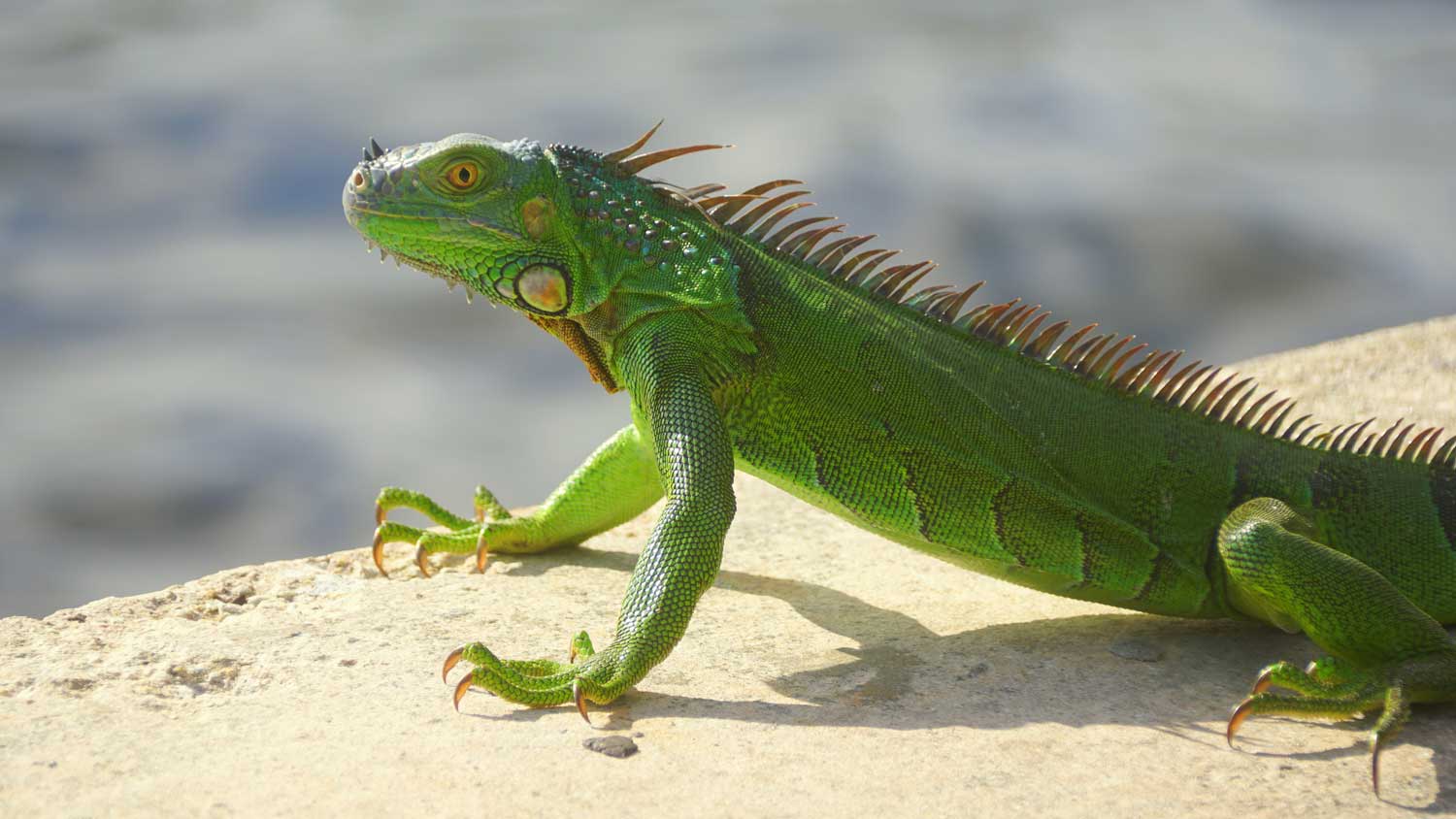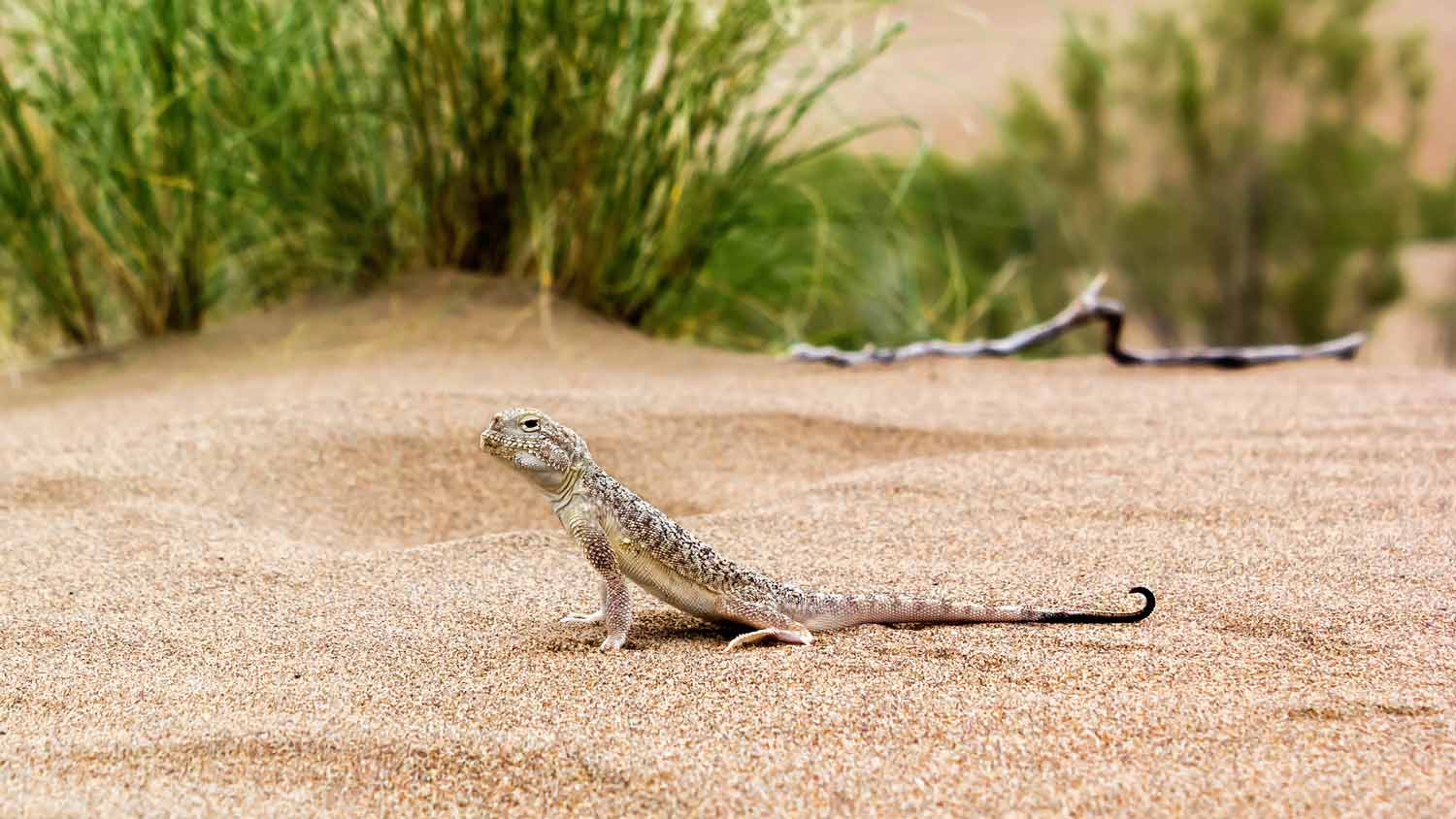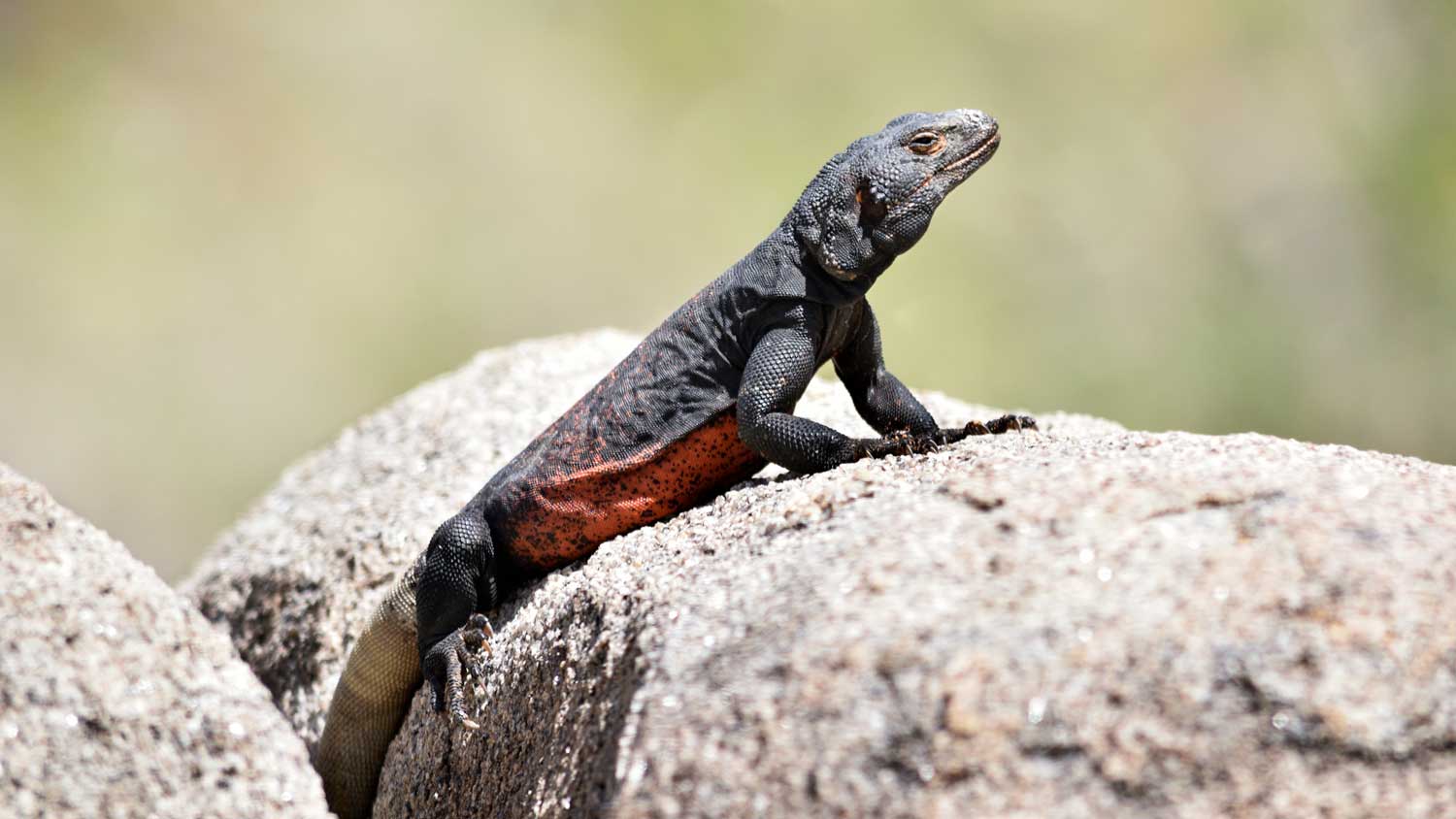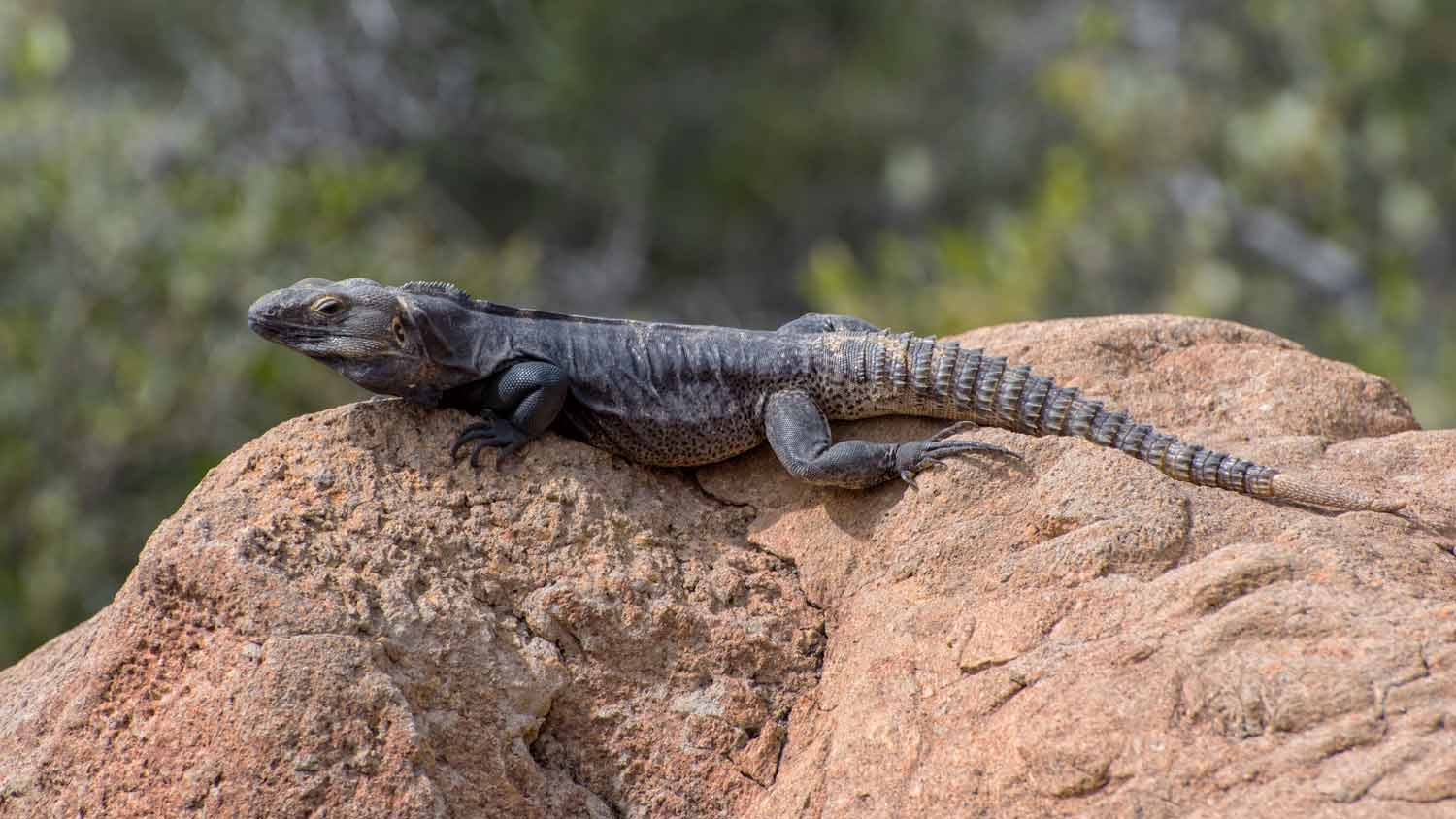The Most Common Types of Iguanas
Get to know your scaly neighbors


The U.S. has many different types of iguanas, each with unique characteristics and habitats. Some are native to the arid regions of the southwestern states, while others are invasive species introduced through the pet trade that wreaks havoc on local ecosystems. The most common types of iguanas are the green iguana, desert iguana, chuckwalla, and spiny-tailed iguana. If you're wondering which type of lizards crawl in your yard, here’s what you need to know about these creatures.
| Iguana Type | Species Status |
|---|---|
| Green Iguana | Invasive |
| Desert Iguana | Native |
| Chuckwalla | Native |
| Spiny-Tailed Iguana | Invasive |
1. Green Iguana

The green iguana is perhaps the most well-known iguana species here in the States. It hails from Central and South America.
Appearance
Green iguanas can grow up to 6 feet long and are known for their green color, but this can change with age, sex, and temperature. Young iguanas are usually bright green, while adults vary from vibrant green to olive or brown, sometimes developing black bands on their sides and tails. During breeding season, males often turn orange, and their jowls and neck fans enlarge to attract mates.
Temperature also affects their coloring. In cooler weather, green iguanas darken to absorb more heat from the sun. This color-changing ability helps them adapt to their surroundings and regulate their body temperature.
Where You’ll Find Them
Green iguanas are invasive lizards that thrive in warm, tropical climates, making places like Florida, Texas, and Hawaii their home. These creatures are arboreal, preferring to live alone in trees, where they feel most at home. However, they are also known to burrow and camp out in shrubs.
Behaviors
Green iguanas munch on native plants and reproduce rapidly. Their burrowing can damage sidewalks and buildings, causing collapse. Additionally, they often raid crops and gardens, causing headaches for farmers and homeowners. Their droppings can also pose health risks to humans and pets.
2. Desert Iguana

Desert iguanas are native to the United States and do their part to maintain a healthy ecosystem.
Appearance
The desert iguana is a medium-sized lizard with a roundish body that is typically 10 to 16 inches long, including the tail. Its sandy white and light gray scales provide excellent camouflage in desert environments. Its long, slender tail has a distinctive pattern of light and dark bands, aiding in balance and swift movement.
Where You’ll Find Them
Their habitat is usually far from human development. They thrive in the Southwest’s hot, arid, desert environments with sandy soils and sparse vegetation. Their range includes southeastern California, southern Nevada, western Arizona, and southwestern Utah.
Behaviors
Desert iguanas contribute positively to their ecosystem through their feeding behaviors. They consume leaves, flowers, and fruits, assisting in seed dispersal and helping maintain plant diversity in the desert. They also occasionally eat bugs, which helps control insect populations. When the temperatures get too extreme, they burrow to escape the heat.
3. Chuckwalla

The chuckwalla is a large, herbivorous lizard native to the Southwest. Five different species exist, and they tend to live in similar habitats.
Appearance
The chuckwalla is a sturdy, flat-bodied lizard that can grow up to 16 inches long and has distinctive loose skin folds along its sides. Its coloring varies with age and sex. Adult males usually have black heads and forelimbs, with body colors ranging from black and red to orange, gray, or yellow, while females and younger chuckwallas display more subdued shades of brown or gray.
Where You’ll Find Them
Chuckwallas generally avoid human-populated areas. They thrive in the hot, dry regions of the Southwest, including Arizona, Nevada, Utah, and the Mojave Desert in California. They are particularly fond of rocky, sandy habitats with plenty of crevices and boulders where they can hide from predators.
Behaviors
Chuckwallas play a key role in keeping ecosystems healthy. They consume a diet of leaves, flowers, cactus fruit, and buds from desert plants like the creosote bush, spreading seeds around. Occasionally, they will ingest insects. Plus, they are cuisine for native animals like hawks, snakes, and coyotes, keeping the local food chain in balance.
For defense, chuckwallas rely on rocks. When they sense danger, these flat-bodied lizards quickly dash into a crevice and inflate their bodies by gulping air, making it nearly impossible for predators to extract them.
4. Spiny-Tailed Iguana

The spiny-tailed iguana is a non-native species to the U.S., originally from Central America. Two different species are currently in the States.
Appearance
Male spiny-tailed iguanas can reach up to 18 inches, plus another 18 inches for their tails, and they are typically larger and more colorful than females. During the breeding season, males may develop vibrant orange around their head and throat, with blue and peach highlights on their jowls. Males also have small dewlaps or chin flaps.
Females are smaller, about 14 inches, with more subdued grayish-brown coloration. Both sexes have the characteristic spiny tails, though the spines are more pronounced in males.
Where You’ll Find Them
Spiny-tailed iguanas prefer rocky, sunlit habitats with plenty of crevices for hiding and basking. Introduced to the U.S. in the 1970s, this invasive species has spread along Florida's east and southwest coasts and nearby islands. They tend to avoid densely populated human areas, favoring more natural, undisturbed environments.
Behaviors
These lizards outcompete native species for food and habitat. For example, spiny-tailed iguanas consume plants that endangered butterflies rely on, potentially threatening those butterfly populations.
The lizards' burrowing behavior damages infrastructure such as sidewalks and seawalls and displaces native species like owls and gopher tortoises. Additionally, the spiny-tailed iguana's rapid reproduction rates allow their populations to proliferate, making mitigating their environmental impacts difficult.
How to Handle Invasive Iguanas
Homeowners looking for how to get rid of iguanas can take steps to manage their presence. Start by making your property less inviting: remove food sources like fruits and pet food, trim trees and shrubs, and install burrow-proof fencing around gardens and yards. Additionally, seal any openings in walls.
Humane traps using the best bait for iguanas are a good DIY solution—place traps where iguanas are frequently seen and follow local regulations for relocation.
Alternatively, you can hire a reputable local animal removal service to ensure safe and effective removal. These professionals can also provide invaluable advice on long-term prevention, equipping homeowners with the necessary knowledge to prevent future lizard infestations.




- Your Step-by-Step Guide for Getting Rid of Iguanas
- What Is the Best Bait for an Iguana Trap?
- 14 Incredibly Invasive Trees to Avoid Planting on Your Property
- 7 Common Invasive Plants to Keep Out of Your Garden Beds
- Plant Like a Pro: 9 Gardening Influencers Share Their Secrets to Growing Thriving Plants
- 13 Summer Landscape Tips That’ll Keep Your Grass Green and Plants Thriving
- 47 Landscaping Ideas to Consider for Your Home
- What Animal Is Digging Holes in My Yard? How to Identify and Prevent Common Critters
- The 10 Most Popular Houseplants
- 7 Types of Landscaping Styles for Your Yard










